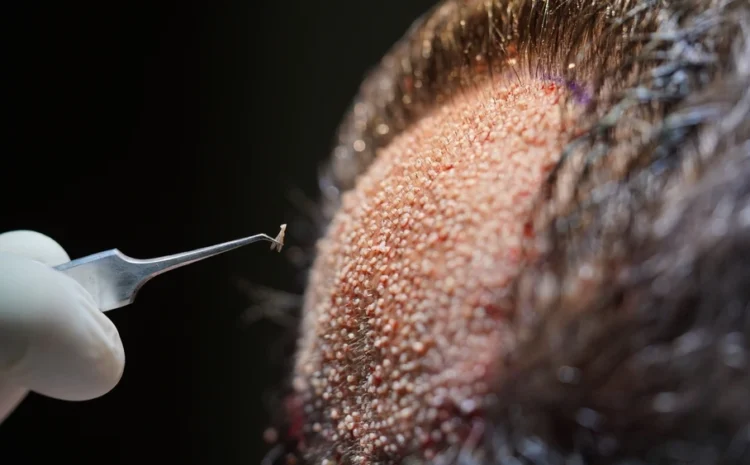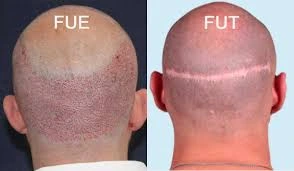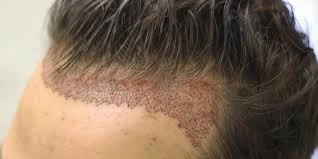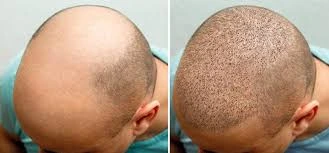
When you start noticing hair thinning and hair loss, you might feel a sense of concern that prompts you to search for a treatment to restore what’s been lost.
If you’re at this stage and considering regaining your hair’s natural density, this article from Prof Clinic will guide you through the FUE hair transplant technique in Turkey, covering the procedure’s details, its benefits and drawbacks, steps, and costs.
What is a FUE Hair Transplant?
You’ve likely heard of the FUE hair transplant technique, which is one of the most common and advanced methods in hair transplantation today.
The Follicular Unit Extraction technique, also called FUE hair, is a sophisticated hair restoration method that involves individually extracting hair follicles from healthy donor areas of the scalp, such as the back or sides of the head.
These carefully extracted follicles are then precisely implanted into areas experiencing hair thinning or hair loss, delivering highly natural-looking results with no large linear scars and a swift recovery.
FUE and FUT
Understanding the differences between the two techniques will help you make the most suitable decision for your condition and expectations from the procedure.
Method of Follicle Extraction
The primary difference lies in how follicles are harvested from the donor area. The FUE hair technique is a precise, microscopic process where each follicle is individually extracted using a specialized tool. In contrast, the FUT (Follicular Unit Transplantation) technique involves the surgeon removing a thin strip of scalp from the donor area, from which follicles are then meticulously separated under a microscope.
Appearance of Scars and Recovery Time
FUE hair transplant leaves tiny, dot-like scars in the donor area that heal quickly and are virtually invisible once hair grows back. On the other hand, FUT leaves a thin, linear scar in the donor area, which can be concealed with longer hair but may be noticeable if you opt for very short hairstyles.
Number of Follicles Transplanted in a Single Session
Generally, the FUE technique allows for the harvesting of a larger number of follicles in a single session, making it a preferred choice for cases with significant hair loss requiring a high volume of grafts to achieve the desired density. However, FUE may require multiple sessions for extensive cases, though it offers greater flexibility for those who wish to avoid a linear scar.
Recovery Period
Recovery is faster and more comfortable with FUE, allowing you to return to your daily activities within a few days. In contrast, FUT requires a longer recovery period due to the surgical incision, which takes more time to heal. This difference makes FUE the preferred option for those seeking a quick return to their normal routine.
If you’re finding it difficult to decide on the best technique for you, the specialized medical team at Prof Clinic will assess your condition and guide you toward the optimal choice. Contact us now to receive your free consultation.
Also read: What is a Hair Transplant? Hairline Transplant (Comprehensive Guide)

Benefits & Risks of FUE Hair Transplant
Before deciding on the FUE technique, it’s essential to understand its advantages and disadvantages to make an informed choice you won’t regret. Below, we outline its benefits and drawbacks:
Benefits of FUE Hair Transplant
Natural-Looking Results
The FUE technique delivers remarkably natural results, as the doctor implants follicles at the precise angle and direction to blend seamlessly with your existing hair growth. This means the transplanted hair appears entirely natural, making it nearly indistinguishable from your original hair.
Minimal Scarring
Unlike other techniques, FUE does not involve removing a strip of scalp, so it leaves no large linear scar in the donor area. Instead, it results in tiny, dot-like marks that fade over time and become virtually invisible, reducing post-procedure discomfort and speeding up recovery.
Shorter Recovery Time
Due to its less invasive nature, recovery after FUE hair transplantation is faster and more comfortable. You can return to your regular daily activities much sooner compared to other methods, and it offers the flexibility to choose shorter hairstyles later on.
Versatile Applications
FUE is a highly versatile technique, suitable not only for scalp hair restoration but also for precise transplantation in delicate areas like the eyebrows or beard. It can be effectively adapted to address general thinning or localized baldness.
Risks of FUE Hair Transplant
Longer Procedure Time
Since follicle extraction is performed individually for each follicle, the procedure can take significantly longer than FUT, especially if a large number of grafts are needed. This may mean spending more hours in the clinic to complete the procedure in one or multiple sessions.
Shaving Before FUE Transplant
In most FUE hair transplant cases, shaving the donor area is required to ensure precision during extraction and clear visibility of the follicles. This may be inconvenient if you prefer to keep your hair long.
Limitations on Follicle Numbers
For cases requiring a very high number of follicles (over 4,000–5,000 grafts), FUE may not be the optimal choice for a single session, as it relies on extracting follicles from a relatively limited donor area. This may necessitate multiple sessions, increasing both time and cost.
Higher Cost
Compared to some other hair transplant techniques, FUE is more expensive due to its high precision and time-intensive nature. This factor may pose a challenge for those with limited budgets, requiring careful comparison of available options before making a final decision.

FUE hair transplant procedure
Initial Consultation and Planning
The process begins with a thorough evaluation of your hair and scalp condition, identifying the causes of hair loss. During this stage, the new frontal hairline is carefully designed to complement your facial features and expectations, while the donor area and the number of follicles needed to achieve the desired density are determined.
Anesthesia and Follicle Extraction
The donor area, typically located at the back or sides of your head, is numbed with local anesthesia to ensure your complete comfort during the procedure. The doctor then uses a highly precise tool to individually extract hair follicles, carefully selecting the strongest and healthiest ones.
Recipient Area in Hair Transplant
This is a critical step for achieving natural results. The doctor creates tiny channels in the area where the hair will be transplanted, using precise tools (such as sapphire blades or Choi pens), while considering the angle, direction, and depth of your natural hair growth.
Follicle Implantation
Once the channels are created, the extracted follicles are implanted into them. The doctor places each follicle in its designated spot, ensuring even and harmonious distribution to achieve maximum density and a natural appearance. This stage requires great precision and patience to deliver optimal results.
Post-Procedure Care and Follow-Up
After the transplantation is complete, you’ll receive detailed instructions on how to care for your scalp and transplanted hair during the first days and weeks. These instructions cover how to wash your hair, medications to take, activities to avoid, and scheduling follow-up appointments.
At Prof Clinic, we prefer to explain each step of the procedure in detail to alleviate any fears or concerns you may have. Contact our team for a deeper explanation and answers to all your questions.
FUE Recovery
This is the most critical stage to ensure the success of the hair transplant. This period requires special care and patience to allow the transplanted hair to grow healthily.
- First Few Days (1–3 Days): You’ll notice small red crusts and mild swelling in the transplanted area and around the forehead, which is normal. You must follow the doctor’s instructions for gently washing your hair to avoid disturbing the follicles.
- First to Second Week (4–14 Days): The crusts will gradually fall off, and you may experience some shedding of the transplanted hair, known as “shock loss.” This is a normal, temporary phase that paves the way for new, permanent hair growth.
- First to Third Month (1–3 Months): During this time, the hair follicles enter a resting phase before regrowth begins. You may not notice significant growth yet, but this is a vital period for stabilizing and strengthening the follicles.
- Fourth Month Onward (4 Months and Beyond): You’ll start to see actual growth of the transplanted hair, which will appear gradually and increase in thickness and density. Full, final results typically take 12 to 18 months.
If you have any questions about the recovery phase or need a personalized care plan, contact Prof Clinic now. Our experts are ready to support you every step of the way in your journey to restore your hair’s density.

FUE hair transplant cost
When you begin exploring the option of an FUE hair transplant, the cost is likely a primary concern. The FUE hair transplant cost varies worldwide, influenced by factors such as the surgeon’s expertise, the clinic’s geographic location, and the number of follicles needed. On average, the FUEf transplant cost globally ranges between $4,000 and $15,000 per session, and this FUE hair transplant price may increase for cases requiring a large number of follicles or multiple sessions.
FUE turkey cost
Turkey, particularly Istanbul, stands out as a premier global destination for hair transplantation, drawing many with its high-quality services and competitive pricing. At Prof Clinic, the fue Turkey cost for FUE hair transplantation, including techniques like Sapphire FUE or DHI, ranges between €2,500 and €2,700, with the basic package covering the procedure itself. Comprehensive packages are also available, which may include additional services like accommodation or supportive treatments, providing flexible options tailored to your needs and budget. For those curious about the Turkey fue hair transplant cost or fue cost per graft, these packages offer cost-effective solutions without compromising quality. The overall FUE cost at Prof Clinic remains highly competitive compared to global standards.
Prof Clinic for The FUE Hair Transplant in Istanbul Turkey
When you decide to undergo a hair transplant, choosing the right FUE clinic in Turkey makes a significant difference in your experience and results. At Prof Clinic, we focus on delivering an exceptional experience in FUE hair transplantation, striving to offer the best fue hair transplant through our specialized medical team with extensive experience in treating various hair loss cases for both women and men.
We adhere to the highest international quality standards and use the latest technologies to ensure you achieve completely natural results that boost your confidence, all within a comfortable and supportive environment.
FUE hair transplant turkey before and after
Seeing the real transformation in others’ hair is the best evidence of the effectiveness of FUE hair transplantation. Reviewing FUE hair transplant before and after photos from our clients’ experiences at Prof Clinic in Turkey will enable you to assess the quality of the results and encourage you to make your final decision.
If you’re ready to start your journey toward thicker, more beautiful hair, contact Prof Clinic now. Our experts are prepared to evaluate your condition and create a personalized treatment plan to ensure the best positive transformation you deserve.

FAQs about fue hair transplant turkey
How long does a FUE hair transplant last?
The results of the best FUE hair transplant are typically permanent in most cases because the transplanted follicles are taken from areas genetically resistant to hair loss. These follicles retain their genetic characteristics and continue to grow naturally and permanently in their new location.
What is better, FUE or FUT?
There’s no one-size-fits-all answer; the best option depends on your condition, hair loss pattern, and the size of your donor area. FUE, offered at a top FUE clinic like Prof Clinic, is preferred for minimal scarring and faster recovery, while FUT may be better for cases requiring a very large number of follicles in a single session.
Is FUE or DHI better?
DHI is an advanced variation of FUE and is considered superior in some aspects because it allows direct implantation of follicles without the need to create channels beforehand, offering greater precision in controlling the angle and depth of hair growth. This contributes to more natural-looking results, as seen in (fue hair transplant turkey before and after) photos, and reduces the time follicles remain outside the body.
What is FUE in hair transplant?
FUE stands for Follicular Unit Extraction, a technique used in hair transplantation where hair follicles are individually and directly extracted from the donor area using a precise tool and then implanted into the recipient areas. This method, known for its natural results, is a hallmark of the (best fue hair transplant) and leaves no large linear scar.
How much does a 2000 FUE graft cost?
The FUE transplant cost for 2,000 follicles varies depending on the FUE clinic, country, and surgeon’s expertise. At clinics like Prof Clinic in Turkey, the Tturkey FUE hair transplant cost is often offered in packages covering a specific number of grafts. The total FUE hair transplant price for a package typically covering up to 6,000 grafts ranges between €2,500 and €2,700. The (fue cost per graft) can be estimated within this range, making it a cost-effective option for many.
Can I wear a hat after FUE?
It’s generally advised to avoid wearing a hat for the first few days after an FUE hair transplant to protect the newly transplanted follicles from pressure or friction that could affect their stability. After about a week, with your doctor’s approval, you can start wearing loose, lightweight hats to complement your (fue hair transplant turkey before and after) results.
Does FUE leave scars?
The FUE technique does not leave a large linear scar like FUT. Instead, it results in tiny, circular, dot-like scars in the donor area. These marks are virtually invisible once healed and covered by short hair growth, offering greater flexibility in choosing hairstyles and enhancing the appeal of the best fue hair transplant.
Does FUE require shaving?
In most cases of FUE hair transplantation, the procedure requires partial or full shaving of the donor area to ensure precision in follicle extraction and better visibility for the doctor. However, advanced techniques like unshaven FUE hair transplant allow transplantation without full shaving, though they may not be suitable for all cases and typically increase the (fue cost).

